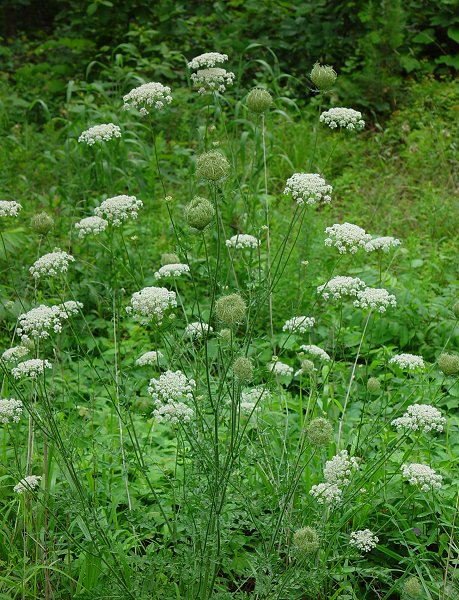Daucus carota L.
Queen Anne's Lace

Introduced
CC = *
CW = 5
MOC = 76
© DETenaglia
Daucus carota L.Queen Anne's Lace | |
 |
Introduced CC = * CW = 5 MOC = 76 |
© DETenaglia |
|
Family - Apiaceae Habit - Annual or biennial forb from a large taproot. Stems - Erect, to 1.5 m, branching, single from base, sparsely to densely pubescent with spreading to recurved, broad-based, stiff hairs.
Leaves - Alternate, petiolate, bipinnately divided, the sheathing bases not or only slightly inflated. Basal leaves long-petiolate, the petioles progressively shorter upward. Blades 5-20 cm long, oblong to triangular-ovate in outline, 2-4 times pinnately compound and/or dissected, the ultimate leaflets or segments 2-12 mm long, 0.5-2.0 mm wide, linear to lanceolate, short-tapered to a sharp point at the tip, the margins entire or few-toothed or-lobed, sparsely to moderately hairy, especially along the margins and veins.
Inflorescences - Terminal and axillary, compound umbels, long-stalked, the stalks pubescent with mostly recurved, broad-based, stiff hairs. Involucre of 4-15 bracts 4-40 mm long, leaflike, pinnately 1-2 times dissected with linear segments, rarely entire, spreading to loosely ascending at flowering, spreading to loosely reflexed at fruiting, glabrous or sparsely hairy. Rays 3.0-7.5 cm long, roughened or hairy, spreading to loosely ascending at flowering, the innermost ones shorter than the outer ones, the umbels thus appearing flat-topped at flowering, curving upward and inward at fruiting, the umbels thus becoming more or less oblong in outline as the fruits develop. Involucel of 5-13 bracts, these linear, shorter than to more commonly slightly longer than the rays, with broad, thin, white margins, at least toward the base, entire or less commonly pinnately few-lobed toward the tip, glabrous or sparsely hairy. Flowers 5-20 in each umbellet, the stalks 1-8 mm long, roughened, unequal in length. Central floret in each umbellet sessile.
Flowers - Sepals absent or consisting of minute triangular teeth. Petals 5, obovate, notched into 2 unequal lobes at the tip, those of the outermost flowers in some umbels often somewhat enlarged, white, the innermost flower of each umbellet frequently with a dark purple corolla. Stamens 5, falling early. Ovaries hairy.
Fruits - Schizocarps 3-4 mm long, oblong-elliptic to oblong-ovate in outline, flattened dorsally, brown, each mericarp with 5 inconspicuous primary ribs, these slender, nervelike, brown, lacking wings, hairy, and also with 4 secondary ribs between the primary ones, these, slender, straw-colored, prominently winged, the wing margins with a row of flattened bristles having pointed or very minutely barbed or hooked tips.
Flowering - May - October. Habitat - Streambanks, tops of bluffs, glades, forest openings, fields, pastures, fencerows, roadsides, railroads, open disturbed areas. Origin - Native to Europe. Lookalikes - Broadly, several other members of the Apiaceae, most of which are less common. Other info. - Dan's friend Hope once observed, "Queen Anne's Lace is to the carrot as Asian jungle fowl is to the chicken." Indeed, Daucus carota is the wild form of the cultivated carrot. It is also an extremely common weed in Missouri, being found statewide as well as in every state in the continental U.S. The plant is easily recognized and familiar to most people. The lookalikes generally have leaves which are different from the carrot-like leaves of this species. The center of the inflorescence often bears a single dark floret, but this is sometimes absent, and indeed plants lacking it have been named as a form of the species (fo. epurpuratus). The function (if any) of this oddity has been debated, with some botanists proposing that the dark floret mimics a nectaring insect, serving as a sort of insect decoy to attract pollinators. As the umbel matures it folds in on itself, trapping the spiny fruits until some animal (or human) brushes the plant and picks up a load of the fruits to transport elsewhere. Photographs taken in Vale, NC., 5-11-03, and in the Ozark Scenic Riverways, Shannon County, MO., 6-13-03 (DETenaglia); also at Busch Wildlife Area, St. Charles County, MO, 8-16-2008, LaBarque Creek Conservation Area, Jefferson County, MO, 7-10-2016, Little Lost Creek Conservation Area, Warren County, MO, 7-8-2020, and Don Robinson State Park, Jefferson County, MO, 7-10-2020 (SRTurner). |